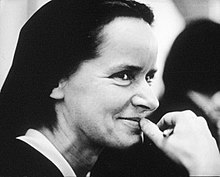Corita Kent | |
|---|---|
 | |
| Born | Frances Elizabeth Kent November 20, 1918 Fort Dodge, Iowa, US |
| Died | September 18, 1986 (aged 67) Boston, Massachusetts, US |
| Known for | Silkscreen, serigraphy |
| Movement | Pop art |
| Website | corita |
Corita Kent (November 20, 1918 – September 18, 1986), born Frances Elizabeth Kent and also known as Sister Mary Corita Kent, was an American artist, designer and educator, and former religious sister. Key themes in her work included Christianity, and social justice. She was also a teacher at the Immaculate Heart College.[1]
Corita was born Frances Elizabeth Kent on November 20 in the year of 1918. At 18 years of age, Kent entered the Sisters of the Immaculate Heart, which were known to be very progressive and welcomed creativity. Frances joined a teaching order, taking the name Sister Mary Corita. She received a bachelor's degree at Immaculate Heart College and a master's degree at University of Southern California. She was the head of the art department at Immaculate Heart College.[1] where she also taught a wide variety of different painting styles. Her artwork contained her own spiritual expression and love for her God.[2]
Kent's primary medium was screen printing, also known as Serigraphy.[3] She became self-taught after she sent away for a DIY silk screening kit.[4] Her innovative methods pushed back the limitations of two-dimensional media of the times. Kent's emphasis on printing was partially due to her wish for democratic outreach, as she wished for affordable art for the masses.[5] Her artwork, with its messages of love and peace, was particularly popular during the social upheavals of the 1960s and 1970s.[6]
Due to opposition from Cardinal James McIntyre (who had a particular dislike for Kent), the sisters would eventually be forced out of their schools in Los Angeles—with the exception of the college—and most of the sisters left the order entirely, while keeping the larger school. Kent, however, would move to the East Coast and begin to work independently.
After a cancer diagnosis in the early 1970s, she entered an extremely prolific period in her career, including the Rainbow Swash design on the LNG storage tank in Boston, and the 1985 version of the United States Postal Service's special Love stamp.[7]
In recent years, Corita has gained increased recognition for her role in the pop art movement. Critics and theorists previously failed to count her work as part of any mainstream "canon," but in the last few years there has been a resurgence of attention given to Kent. As both a nun and a woman making art in the twentieth century, she was in many ways cast to the margins of the different movements she was a part of.
Corita's art was her activism, and her spiritually-informed social commentary promoted love and tolerance.
- ^ a b "Corita Kent Biography". The Corita Art Center. Retrieved December 25, 2019.
- ^ "Corita Kent Biography, Life & Quotes". The Art Story. Retrieved December 25, 2019.
- ^ "An investigation of some-screen prints by Corita kent" (PDF). Archived from the original (PDF) on July 4, 2017. Retrieved December 18, 2019.
- ^ "Corita Kent | 2016 AIGA Medalist". April 18, 2016. Archived from the original on December 21, 2021 – via www.youtube.com.
- ^ Dammann, April (2015). Corita Kent: Art and Soul. The Biography. Santa Monica, California: Angel City Press. pp. 10–92. ISBN 978-1626400207.
- ^ Kurhi, Eric (February 14, 2011). "Work of pop art icon Corita Kent coming to Hayward, Castro Valley galleries". Oakland Tribune. Retrieved November 25, 2014.
- ^ Winick, Les (April 7, 1985). "Usps Sends Its Fourth Message Of Love To Avid 'Special Regular'". Chicago Tribune. Retrieved November 25, 2014.